“Do you really need a full-time hire for that role?”
It’s a question more Indian businesses are asking, and for good reason. With market demands shifting faster than ever, teams are under pressure to stay lean yet productive. Whether you’re scaling a tech product, setting up a shared service centre, or closing urgent delivery gaps, the traditional hiring model isn’t always the best fit.
At such times, contingent employment proves to be a flexible, scalable, and cost-efficient option. It’s helping HR heads, BU leaders, and CHROs rethink workforce planning in a very real way. From contract tech talent to interim finance staff and project-based roles, contingent hiring has moved beyond short-term fixes. It’s now a strategic tool for execution.
In this blog, you’ll explore what contingent employment truly means, the types of roles it covers, when to consider it, and how to avoid common pitfalls.
TL;DR
- Contingent employment offers flexible, non-permanent staffing options, such as freelancers, contractors, and temporary workers, to address short‑term needs without long-term commitments.
- Key benefits include cost control, faster hiring, and access to niche talent, especially valuable during rapid growth phases or hiring freezes.
- Challenges such as engagement, compliance, and communication can be overcome with a structured onboarding process and clear procedures.
- Strategic use of contingent roles can support seasonal peaks, specialised projects, and sudden skill gaps efficiently.
- When managed effectively, this approach enables businesses to stay agile, productive, and budget-conscious in a dynamic market.
What is Contingent Employment?
Contingent employment refers to hiring individuals on a non-permanent basis. These professionals work on specific projects, fixed-term contracts, or urgent roles without being on your direct payroll. Timelines, tasks, or immediate organisational needs define their employment.
Unlike full-time staff, contingent workers are brought in to support short-term goals. You may engage them for three months, six months, or till project completion. This approach allows you to meet immediate business goals without the long-term commitment associated with permanent hiring.
If you’re building a workforce that’s agile and responsive to business demands, understanding contingent employment could be valuable. It’s becoming a standard workforce strategy across mid to large Indian enterprises.
Key Characteristics
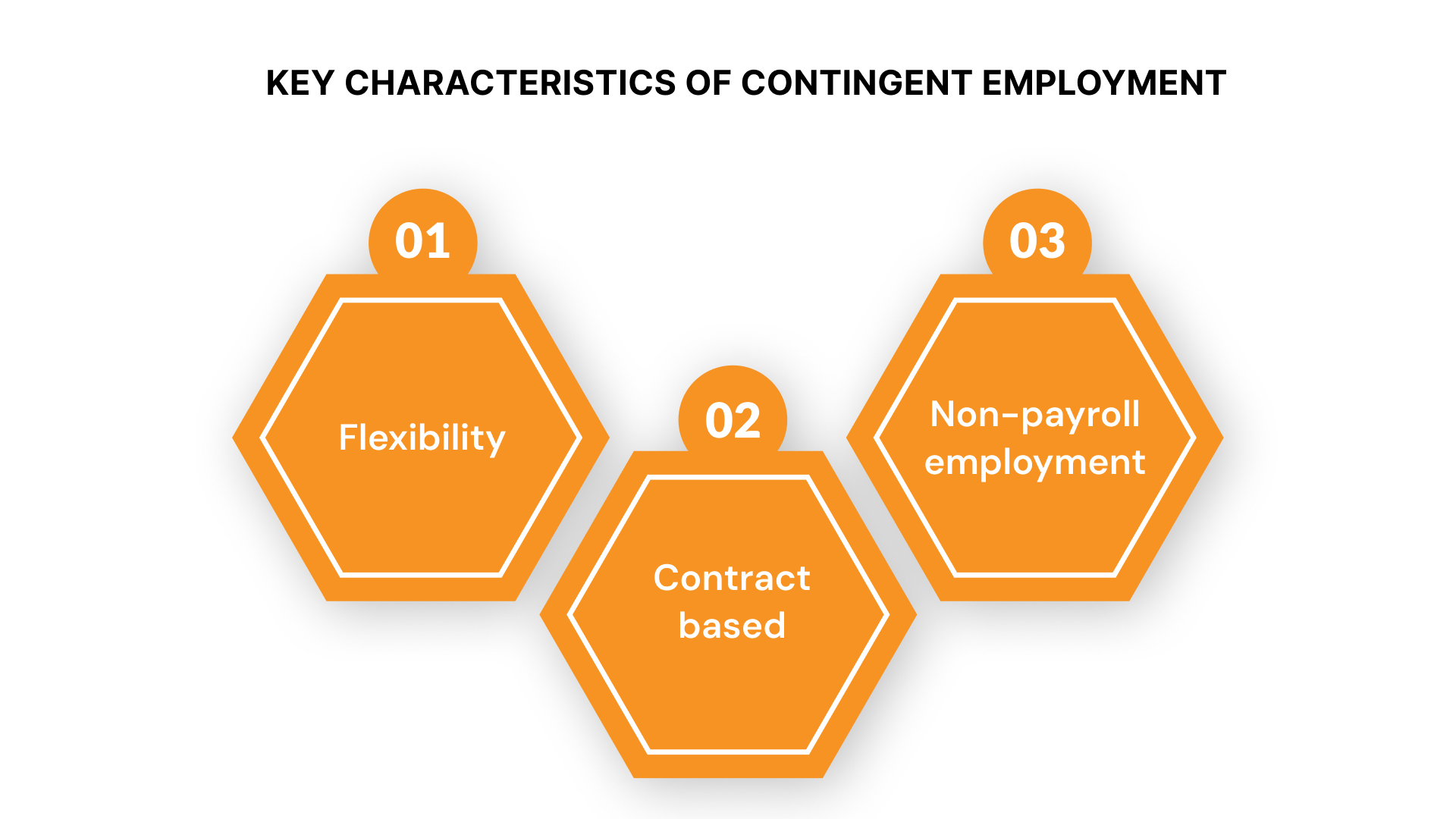
You’ll find that contingent employment is marked by three core features:
- Flexibility: You can scale talent up or down based on your changing needs. Whether it’s a sudden project requirement or market expansion, this model adjusts quickly.
- Short-term or contract-based: These workers are typically hired for a set period, often through staffing firms. Their engagement is legally bound by a contract.
- Non-payroll employment: Most contingent workers are employed through staffing partners, such as V3 Staffing. This means your internal teams aren’t burdened with onboarding, compliance, or payroll responsibilities.
This setup is especially effective for roles in IT, engineering, shared services, and even BFSI sectors, where demands shift quickly.
How Contingent Employment Differs from Permanent Hiring
Permanent employees are long-term assets who grow within your business. They receive benefits, training investments, and are part of your organisational structure.
Contingent workers, on the other hand:
- Do not receive long-term benefits or severance
- Are not involved in internal career progression
- Often work off-site or through third-party firms
- They are hired to solve immediate skill or capacity gaps
This distinction matters when you’re planning headcount or budgeting across business units. Contingent hiring helps you stay lean while maintaining output.
Need more details? Understand the differences between different hiring models →
Current Trends in India and Globally
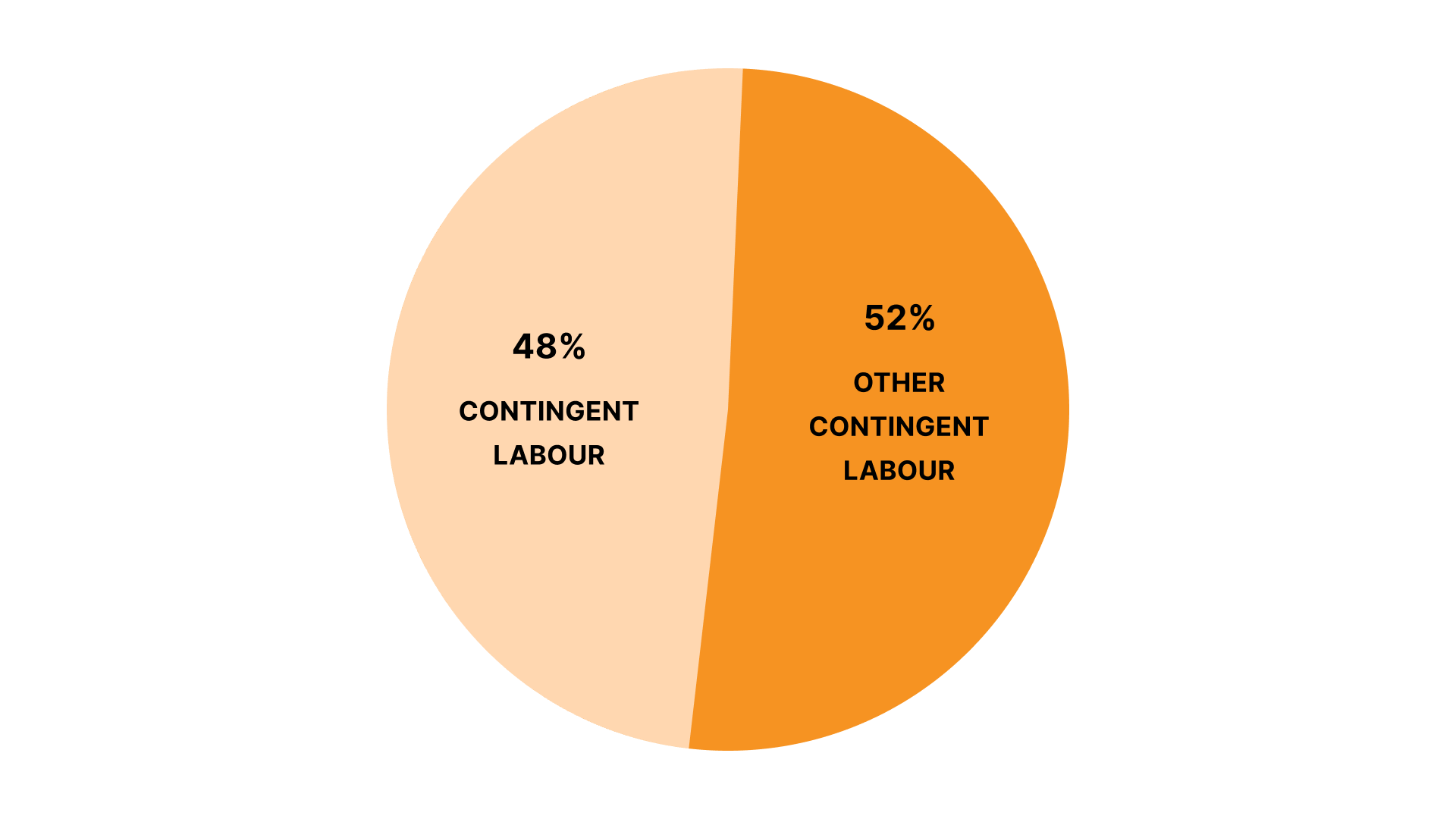
A study on APAC hiring (including India) projects firms in Asia-Pacific growing their use of contingent labour, 48% rely on recruiting firms, and APAC’s contingent market is expected to grow at a 6.3% CAGR through 2032.
Two factors drive this shift:
- Increased project-based work, especially in IT and engineering firms
- Cost and compliance efficiencies, particularly for BFSI, healthcare, and shared services sectors
With multi-location firms expanding into Tier-II cities, contingent hiring ensures faster deployment and localised reach, without stretching internal hiring teams.
Let’s explore the various types of contingent workers businesses commonly engage.
Types of Contingent Employment
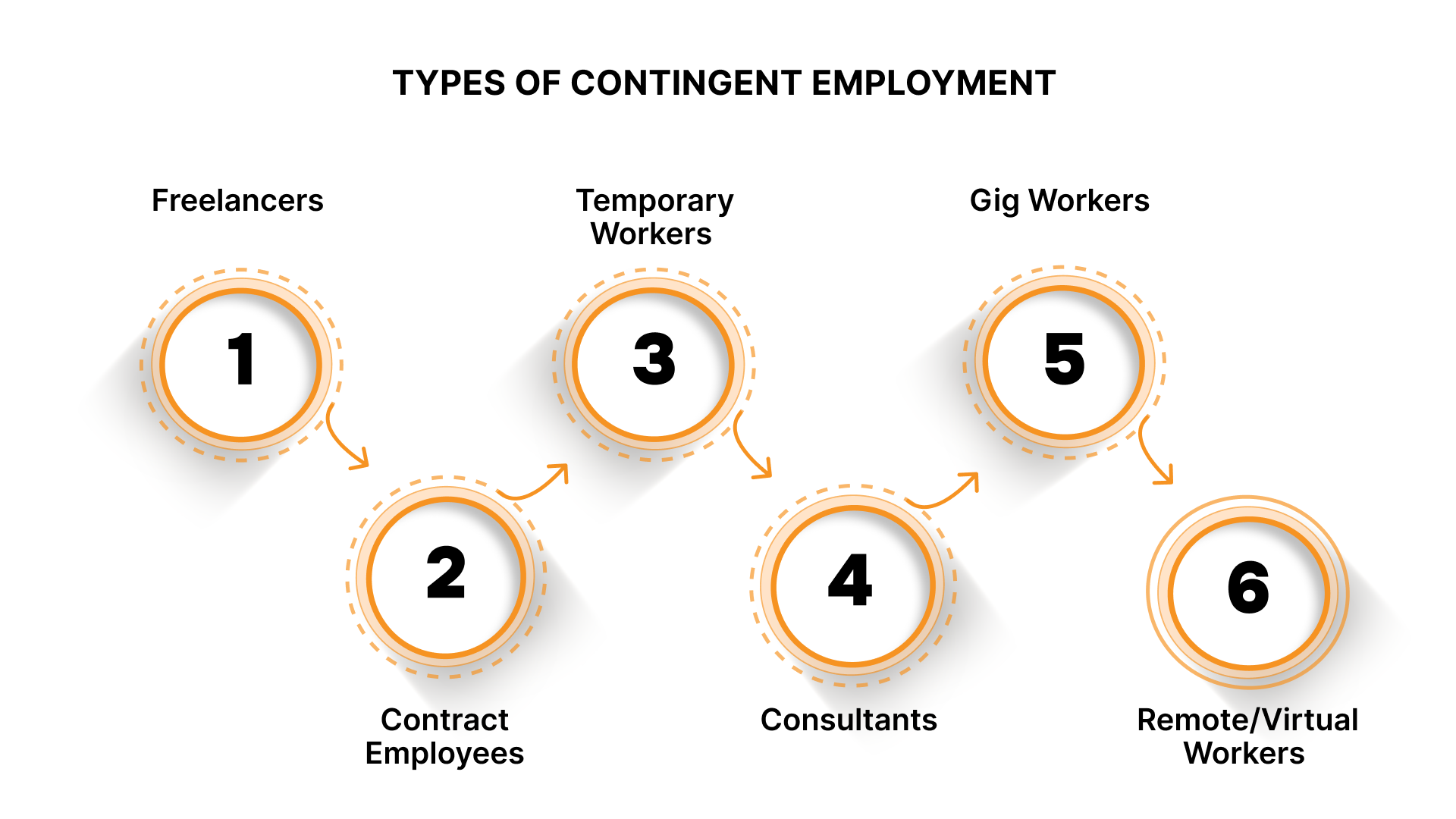
Contingent employment comes in various forms, each built to address specific business needs. Whether you’re scaling a tech team or managing seasonal peaks in operations, choosing the right category helps you stay efficient without adding long-term headcount.
Here’s a structured overview of the most common types of contingent workers:
1. Freelancers
Freelancers are self-employed professionals who take on task-based assignments. You can hire them for specific deliverables, without long-term obligations.
They’re commonly used for creative, tech, digital marketing, and consulting tasks. For example, a GCC building an employer brand may hire freelance content writers or UI designers for short-term work.
Freelancers give you flexibility. You pay only for the task, not for their time beyond it. However, you’ll need clear expectations and strong communication to ensure delivery.
2. Contract Employees
Contract employees are hired for a fixed duration, offering flexibility for both employers and workers. These employees can provide specific expertise for short-term projects, making them a valuable resource for businesses with temporary needs.
At V3 Staffing, we specialise in providing tailored staffing solutions, ensuring that the right candidates are matched with your specific requirements. Our recruitment process is designed to connect you with highly skilled, reliable contract workers.
This model suits BFSI, IT services, and shared services centres where compliance and SLAs matter. For example, a bank expanding into a new region may require 20 contract analysts for six months. Rather than onboarding them permanently, the bank can rely on a staffing partner.
These employees come pre-screened, reducing time-to-hire. Their employment terms are managed externally, making your operations leaner.
3. Temporary Workers
Temporary workers help you meet seasonal demand, fill urgent absences, or complete time-sensitive assignments. Their roles may span a few days to a few months.
Manufacturing firms often use them during production spikes. Retail businesses hire them during festive sales. The hospitality and logistics sectors depend on them to run their daily operations without interruption.
You don’t need to worry about long-term costs. A reliable staffing partner ensures quick deployment and compliance from day one.
4. Consultants
Consultants are subject-matter experts who provide strategic input or specialised expertise. Most are hired at mid- or senior-level positions, typically on a project basis.
You might hire a technology consultant for a platform migration or a finance expert to streamline compliance. These professionals are outcome-driven and typically operate independently.
In contingent employment, consultants help you plug knowledge gaps quickly. They’re ideal for roles that don’t require a full-time internal position but still demand experience and accountability.
5. Gig Workers
Gig workers handle task-based or on-demand jobs, mostly through platform-based models. While more common in sectors such as transportation or food delivery, some enterprises utilise gig talent for events, data entry, or micro-consulting.
Though less relevant for large-scale tech or manufacturing firms, gig roles are expanding into admin and field-level support functions.
If you’re working with distributed teams or need support in remote Tier-II locations, this model offers tactical help.
6. Remote/Virtual Workers
Remote workers are a hybrid category. They may be freelancers, contractors, or consultants, but they work virtually, without being physically present in your office.
This format experienced a significant rise following the COVID-19 pandemic. Today, you may hire a remote QA tester, support executive, or recruiter for a project.
In contingent employment, remote roles offer access to a broader talent pool. For instance, if your Delhi office lacks a specific skillset, you can contract someone from Bengaluru or even a Tier-II city.
Here’s a differentiation table to help you better understand their differences.
| Type of Worker | Engagement Model | Duration | Typical Use Case | Common Industries |
| Freelancers | Self-employed; task-based | Short-term, project-based | Content creation, UI/UX, digital campaigns | Tech, Marketing, Design, Consulting |
| Contract Employees | Full-time (via staffing partner) | Fixed-term (3–12 months) | Regional expansion, shared service support | BFSI, IT Services, Shared Services |
| Temporary Workers | Hourly/daily basis via agency | Very short-term (days to months) | Peak seasons, urgent backfills, task-based ops | Manufacturing, Retail, Logistics |
| Consultants | Independent or agency-deployed | Project-specific | ERP rollouts, compliance audits, digital transformation | Tech, Finance, Healthcare, Strategy |
| Gig Workers | Platform-driven, task-on-demand | Micro-jobs | Field activities, admin tasks, on-ground logistics | Events, Delivery, Admin Ops |
| Remote Workers | Any contingent type, virtual mode | Flexible (project or contract) | Distributed support roles, Tier-II skill access | Tech, Shared Services, Support Functions |
Each of these types serves a different business objective. Understanding when and where to use them can help you run a more agile and cost-effective workforce.
V3 Staffing enables clients to hire such professionals through a structured contract staffing approach with clear SLAs and virtual onboarding support.
Now, let’s understand the business benefits that make this model so effective.
Key Benefits of Contingent Employment for Businesses
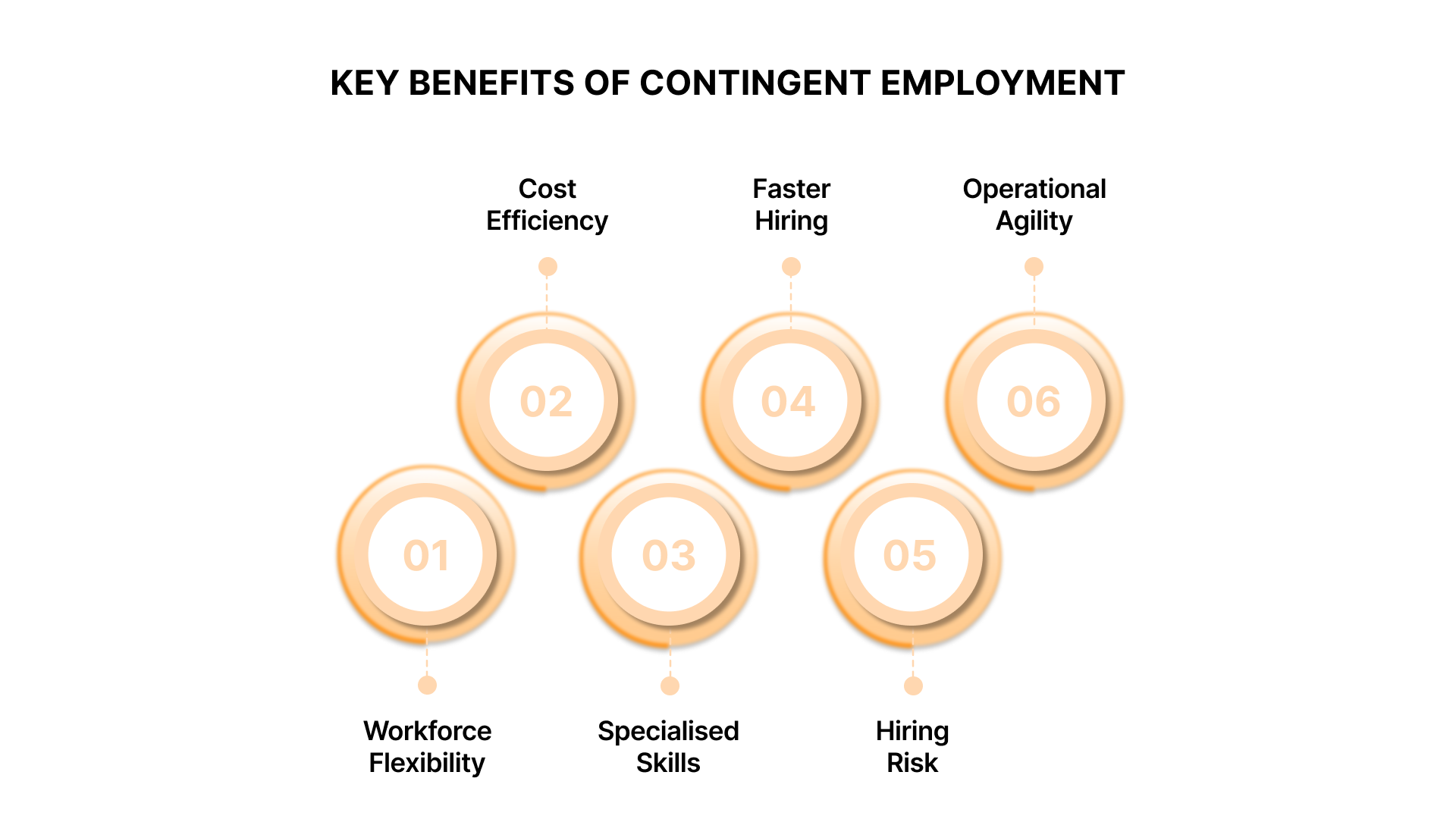
Contingent employment is no longer just a stop-gap arrangement. For many Indian enterprises, it’s now a strategic workforce model that drives speed, control, and cost-effectiveness. Here’s how this approach can benefit your business.
1. Flexibility in Workforce Management
Workforce flexibility is one of the most important reasons companies turn to contingent hiring. It allows you to scale your teams up or down based on current business needs without undergoing lengthy organisational changes.
This is especially relevant during project launches, product testing cycles, or regional expansions. Rather than overcommitting on permanent hires, you can engage skilled professionals for the required duration. Once the task is complete, contracts naturally close, leaving no ongoing obligations.
2. Cost-Efficiency
Hiring permanent employees involves several fixed costs: gratuity, health benefits, paid leave, statutory bonuses, and long-term compliance liabilities. With contingent employment, you pay for time or output, nothing more.
It also helps reduce infrastructure spending. For example, remote contract workers often bring their systems and work from home, lowering your investment in physical setups.
This model supports budget-sensitive teams, especially during periods of unpredictable revenue or capital constraints. You maintain productivity without inflating your cost structure.
3. Access to Specialised Skills
Many roles require specific, often rare, expertise. These may not justify a full-time hire, especially if the need is short-term or project-specific.
Contingent employment gives you access to niche professionals like data analysts, DevOps engineers, technical writers, or ERP consultants only when you need them. This is valuable when working on digital transformations, compliance audits, or innovation rollouts where precision is critical.
Rather than investing in long-term training or onboarding, you get work-ready professionals who can start delivering immediately.
4. Faster Hiring Turnaround
Speed is a crucial factor in meeting business goals. Permanent hiring typically involves multiple approval layers, longer sourcing timelines, and complex negotiations.
Contingent roles, on the other hand, can often be filled in a matter of days. With access to talent pools already vetted by staffing partners, the hiring cycle becomes significantly shorter.
This is particularly helpful during time-sensitive projects or when responding to unplanned attrition.
5. Reduced Hiring Risk
Hiring the wrong person for a permanent role can have a negative impact on team productivity, morale, and long-term outcomes. Contingent hiring allows you to evaluate candidates in real working conditions before making a permanent offer.
This approach, often referred to as a contract-to-hire, helps mitigate hiring risk. You assess performance, alignment, and communication over a defined contract period. If the fit is correct, you can then transition them to a full-time role with confidence.
It provides a practical way to improve the quality of hire without making rushed decisions.
6. Business Continuity and Operational Agility
Unplanned staff absences, sudden demand surges, or seasonal fluctuations can disrupt business operations. Contingent employees ensure these gaps are filled quickly, maintaining service levels and internal delivery timelines.
Temporary staffing or contract-based workers provide immediate support, especially in roles that can’t be left vacant, such as customer support, finance operations, or IT helpdesk. This continuity keeps internal teams focused and avoids burnout during high-pressure periods.
It also helps when you’re undergoing structural changes or testing new service lines, where full-time roles aren’t yet finalised.
When used with intention, contingent employment becomes more than just a staffing solution; it becomes a business tool for sustainable growth and efficiency.
Despite these benefits, there are a few challenges you need to deal with.
Challenges of Contingent Employment (and How to Mitigate Them)
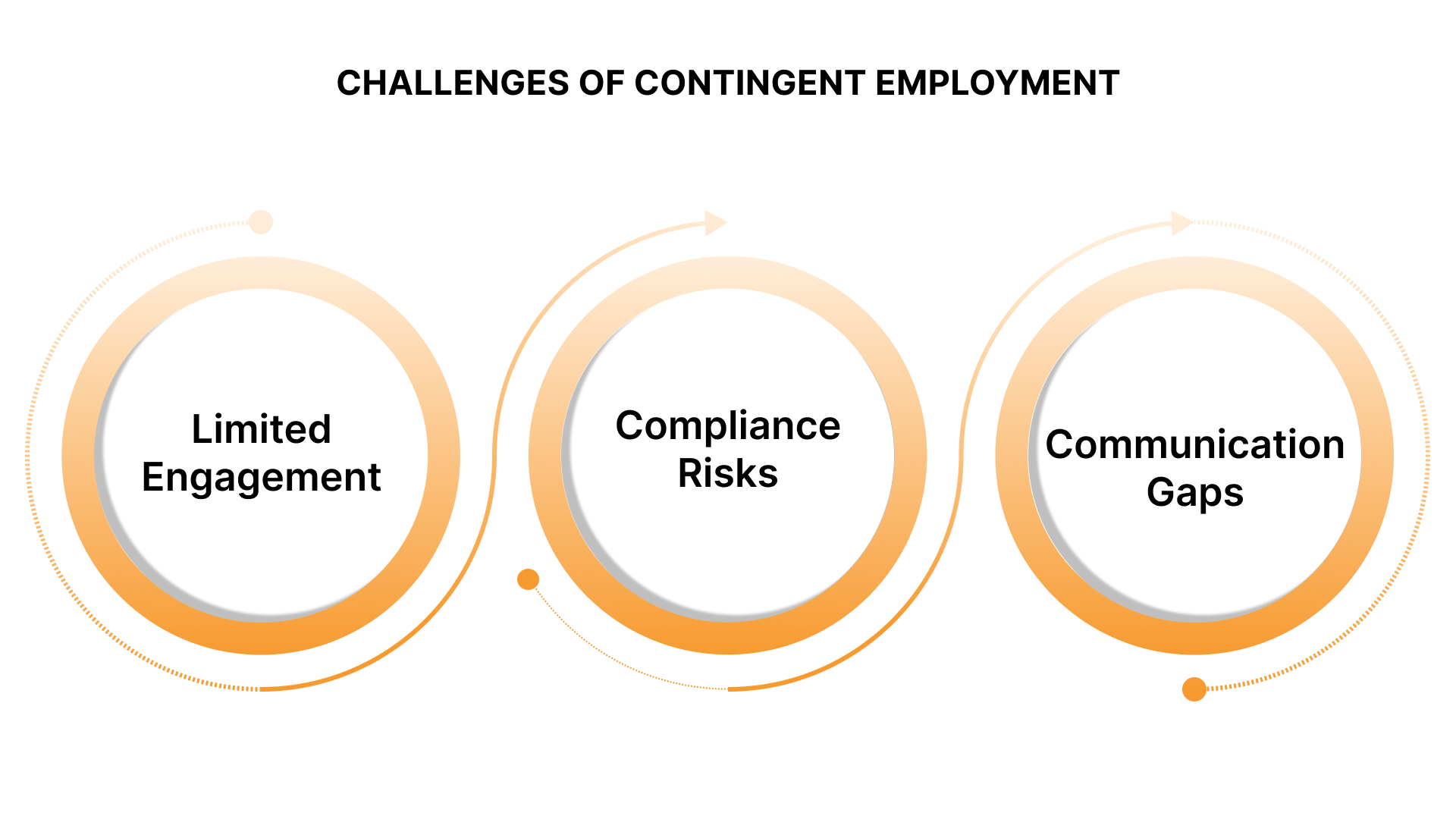
While contingent employment offers clear benefits, it also presents challenges that require attention. Addressing these early helps ensure consistent performance and long-term value from your contingent workforce. Here are the key issues you might face and how to mitigate them with the right approach.
1. Risk of Lower Engagement or Loyalty
Contingent workers may feel disconnected from your company’s culture or mission. Since they’re not part of your core team, loyalty can be limited. This may affect their motivation, especially during long-term projects.
To address this, keep them engaged with clear deliverables, regular check-ins, and fair recognition. Include them in team updates and performance feedback sessions. Even if they’re temporary, they should feel seen and valued.
Building rapport with your contractors helps reduce attrition and improves project continuity.
2. Compliance and Legal Risks
India’s labour laws apply differently to permanent and contract staff. If not handled correctly, you could face regulatory or reputational issues. These risks grow when managing workers across multiple states or contract durations.
You need to ensure contracts are valid, statutory contributions are made, and all tax-related filings are in order. This becomes more complex if you’re hiring at scale or across multiple functions, such as IT, finance, and logistics.
Partnering with a staffing firm that offers compliance support helps mitigate this. They manage labour law adherence, documentation, and wage processing, keeping your internal teams focused on delivery.
3. Communication Gaps with Remote or Temporary Workers
Contingent employees, especially those working remotely, may miss key instructions or process updates. This creates alignment issues that affect quality, timelines, or security.
To avoid this, define structured onboarding for all contract hires. Ensure they receive access to required tools, SOPs, and escalation matrices. Set up reporting checkpoints and maintain a single point of contact for task allocation and performance feedback.
Investing time upfront in orientation and documentation goes a long way in maintaining clarity.
How Trusted Staffing Partners Help
Many of the common challenges in contingent employment can be reduced significantly when you engage with the right staffing partner. Firms that understand compliance, hiring timelines, and workforce engagement can bring measurable stability to your contract workforce.
For instance, V3 Staffing supports mid-to-large Indian businesses with:
- Pre-vetted talent pools, ensuring a better role-to-skill match
- Full compliance coverage across states, including documentation and statutory obligations
- End-to-end workforce management, including SLAs, real-time reporting, and issue tracking
Stuck with vacant positions? We can help you onboard reliable talent faster. Talk to our experts.
This structured approach not only speeds up hiring but also improves retention, engagement, and delivery consistency, particularly in contract and temporary roles.
When Should You Consider Contingent Hiring?
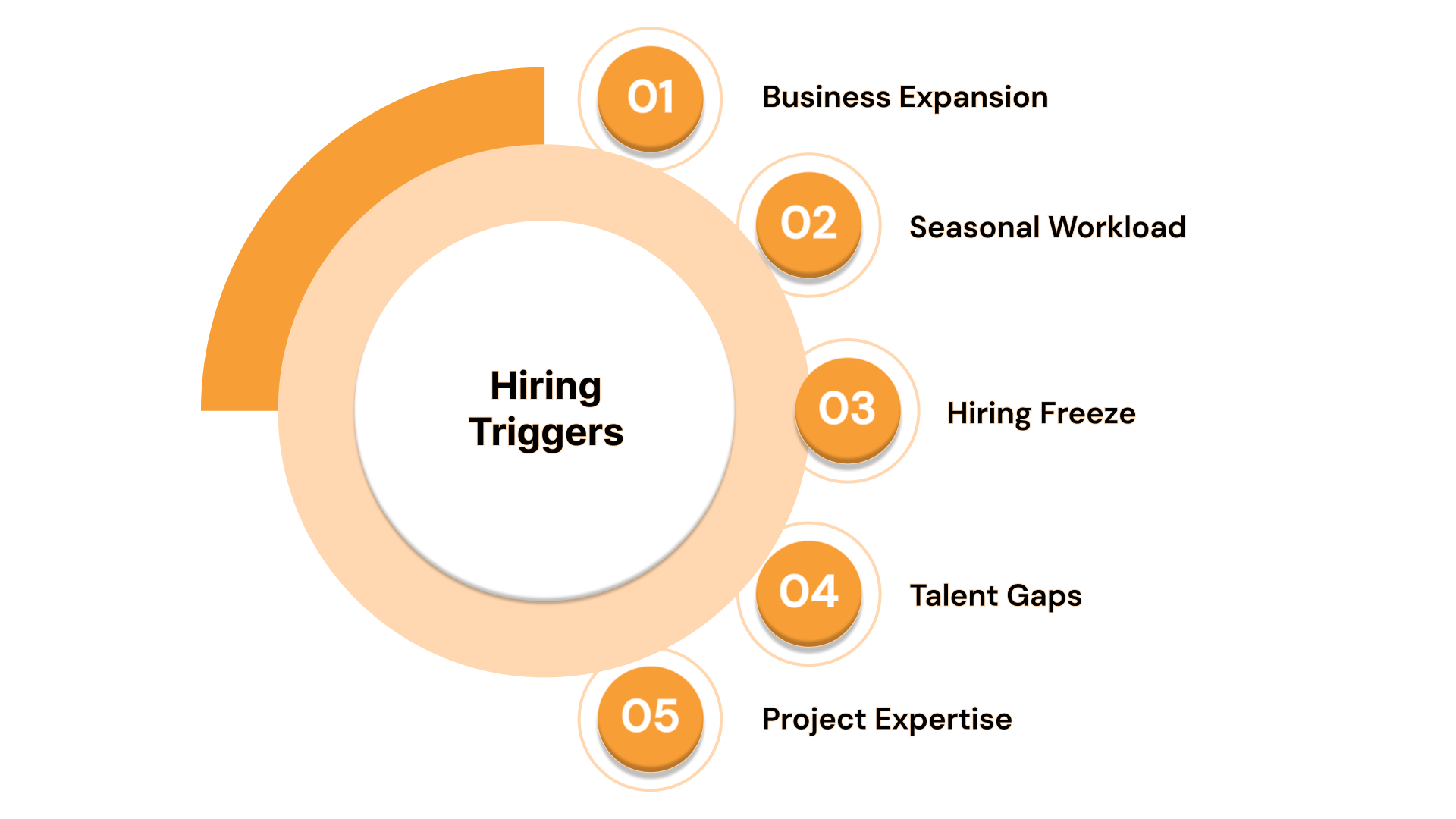
Contingent employment is not just a temporary fix. It’s a practical solution when you need agility without compromising on talent quality or delivery timelines. Here’s when to use this model to manage workforce demand with precision and clarity.
1. During Rapid Business Growth
Expansion often brings unpredictable hiring needs. Your internal team may not have the capacity to fill every role quickly.
Whether you’re opening a new centre in Pune or scaling your operations in Bengaluru, contingent hiring helps you meet demand without delays. You can onboard skilled professionals faster, keep your core team focused, and avoid bottlenecks in delivery.
This is especially useful for GCCs and shared service teams expanding into Tier-II locations.
2. Seasonal or Project-Based Workload
Many industries experience periodic spikes. These could be financial year-end closures, festive season demands, or one-off implementation projects.
Contingent employment allows you to bring in temporary support only for the duration needed. For example, a retail company might hire extra warehouse staff during Diwali sales. A BFSI firm could contract financial analysts during the audit season.
Once the project or cycle ends, the contract closes without any long-term liability.
3. When Permanent Hiring is Frozen
Hiring freezes don’t always mean business slows down. You may still need roles filled due to attrition or the completion of critical deliverables.
In such cases, contingent hiring ensures your business continues to run smoothly. It allows you to plug short-term gaps without breaching headcount limits or HR policies. Contract staffing works well here, offering flexibility without requiring long-term commitments.
4. To Fill Urgent Talent Gaps
Attrition, sick leave, or role backouts can disrupt operations. Waiting weeks to refill positions isn’t always an option.
Contingent workers help fill these urgent gaps quickly. A contract recruiter, for example, can immediately support your HR team during a hiring surge. Or a QA engineer can step in for a time-sensitive product release. You get the talent you need when you need it, without exhausting internal teams.
5. For Specialised Short-Term Projects
Certain projects require specific expertise that your existing team may not have. These could include IT migrations, compliance audits, ERP implementations, or market research assignments.
Contingent employment helps you hire domain experts only for the time required. There’s no need for permanent hiring, onboarding, or training.
This model works well in product tech, shared services, and consulting-heavy functions where project-based roles are common.
Knowing when to opt for contingent hiring ensures your organisation stays productive and cost-efficient, even under changing business conditions.
Let’s look at how V3 Staffing supports contingent hiring through domain expertise, structured processes, and region-specific delivery.
V3 Staffing’s Expertise in Contingent Workforce Solutions
At V3 Staffing, we help businesses manage contingent employment with speed, structure, and accountability. Our strength lies in sourcing skilled professionals for short- and mid-term roles while keeping hiring compliant and scalable.
We support clients with a contract staffing engine built for real-world delivery. Our solutions are backed by domain knowledge, robust sourcing channels, and a high-touch recruitment model that meets the expectations of Indian enterprises.
Our Staffing Services Include:
- Contract hiring for tech and non-tech roles
- Project-based staffing with fixed-duration deployment
- Temporary workforce solutions for seasonal or urgent needs
- IT staffing for niche skill sets like DevOps, cloud, QA, and product
- Full compliance support, including documentation, payroll, and statutory filings
- SLA-based delivery, tracking, and reporting
RPO for a Fortune 500 HVAC Giant
One of our prominent partnerships involved a global Fortune 500 HVAC firm establishing a finance shared services centre in India. The client planned to hire 2,000 professionals in two years. They lacked sufficient internal hiring capacity
We deployed a dedicated onsite RPO team that managed sourcing, screening, and interview coordination. Here are the highlights:
- Sourcing-to-L1 selection ratio: 85%
- Interview-to-offer ratio: 30%
- Offer-to-join rate: 85%
- Average time to close a role: 7 days
While this engagement was RPO-focused, the same efficiency and process rigour apply to our contingent employment model, especially for urgent or project-bound talent requirements.
Become a part of our client community. Hire faster and better with us. Contact Us Today.
Take a Step Towards Simplified Hiring
Contingent employment is a strategic workforce model for businesses that need speed, flexibility, and role-specific expertise. Whether you’re managing rapid growth, filling short-term gaps, or balancing cost and capacity, a well-planned contingent hiring approach can give you the control you need without compromising quality.
But execution matters. To truly benefit from contingent employment, you need more than resumes; you need structured delivery, compliance assurance, and accountability.
At V3 Staffing, we bring exactly that. From contract staffing to temporary hiring and RPO, our solutions are built to support mid to large enterprises across IT, BFSI, manufacturing, retail, and shared services. With SLA-based hiring, real-time reporting, and domain-focused sourcing, we help you meet evolving talent demands accurately and on time.
Build a scalable and dependable contingent workforce. Contact our experts to explore how we can support your hiring goals.
FAQs
1. What exactly is transient contingent employment?
Contingent workers are those in roles without a long-term commitment or expectation of ongoing employment. These include freelancers, contractors, temporary staff, and on-call staff brought in for specific tasks or durations.
2. How does a contingent worker differ from a permanent employee?
Contingent workers often lack long-term benefits, career progression opportunities, and employer-sponsored perks. They work on a project or contract basis, while permanent staff are officially on payroll with full benefits.
3. What legal and compliance issues should I watch out for?
Misclassifying a contractor or mishandling documentation can lead to statutory penalties. Employers and vendors often become joint employers and must uphold wage, tax, and safety obligations .
4. When is contingent employment a better choice than permanent hiring?
It suits situations like:
- Rapid scale‑up during project launches
- seasonal peaks or audits
- hiring freezes or urgent role‑fills
- Specialist engagements lasting a few months
You get the required skills quickly, without over‑committing headcount.
5. How can you maintain quality and productivity with contingent teams?
Engage them from day one. Define goals, set regular check‑ins, and ensure they feel part of the team. Straightforward onboarding and structured feedback retain quality and morale.
6. Can contingent employment turn into a permanent hire?
Yes. Many organisations use a “contract‑to‑hire” model to assess fit. This reduces long‑term hiring risk, allowing performance-based decisions before converting roles.


